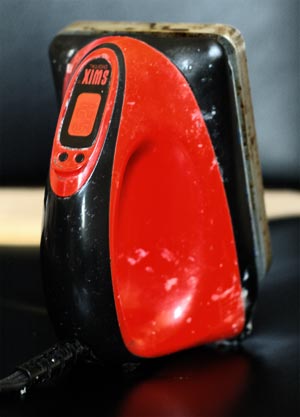Part I reviewed my thoughts on proper wax iron temperature and the importance using a quality digital iron. In Part 2 and 3, I'll review a couple different digital irons: the newest Swix model and a Star Digital Iron.
I used to have an old digital Swix iron - the squarish looking thing that came before the current generation of sleek-looking rounded irons. I loved that iron, used it constantly and repaired it a number of times. But finally it gave up the ghost. So when the new generation of sleek rounded irons came out I picked up a couple of new digital irons. The newly redesigned irons used some new technology to heat the base-plate, and the plate itself was pretty thin and finished in polished stainless steel. The things looked pretty cool, but they didn't work for beans. The engineers claimed that they would hold a temperature setting better than any iron ever made, or some such thing, but the fact was they had far too little thermal mass. The proof was in the operation - the application of waxes required iron settings about 15 or 20 degrees higher than what they should have been, and the application still wasn't sufficiently smooth. I went back to using my old dial-controlled world cup iron. I was sad.

At the beginning of last season Kevin Sweeney came to visit and dropped off a newly redesigned digital iron, the Swix T73 World Cup Digital Iron. This one has a much thicker aluminum base plate (see the image to the right) and has been the best iron I've ever used, without question. It never wavers more than 1 degree C from its target setting, and it's extremely well balanced and smooth in operation.
Speed and precision are important in the work I do. When I need to wax 120 pairs of skis at the end of a large grinding batch I'll get a couple of hours less sleep for every minute longer it takes me to finish a pair of skis. I know the bases I work on are as close to perfect as anybody's going to find. I know the waxes I work with very well. If it takes me three passes with the iron rather than one to ensure that the wax is evenly and completely distributed on the ski then I know that the iron isn't any good. This iron is really good!
And when I'm using it to make race preparations I know exactly what temperature I'm working at. That information combined with experience gives me confidence that I'm not going to damage the skis I'm working on, even though I'm working very quickly. As much as I'd like to claim to know more than the wax companies, these days I pretty much head straight for the recommended iron setting.
Like Nick said, the less time you spend working on your skis the faster they'll be. A really good iron will allow you to work more quickly, more professionally, and more safely. And it will make me happy because your skis will look better the next time I see them for grinding.
Given what you spend on your skis, not to mention flex evaluation, grinding and heatbox work, the investment in a good digital wax iron makes pretty good sense. If you find this iron in your local ski shop, make very certain that it's the newer model with a thick aluminum base-plate or you're bound to be bitterly disappointed.
Next week: my review of the Star Digital Iron - an even better iron!



